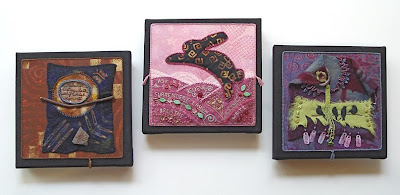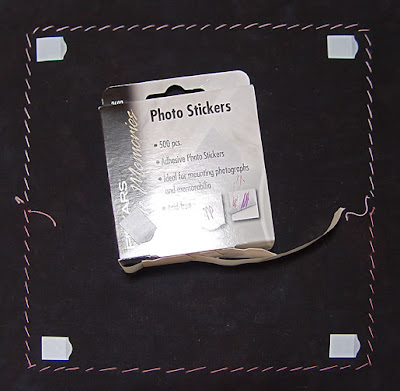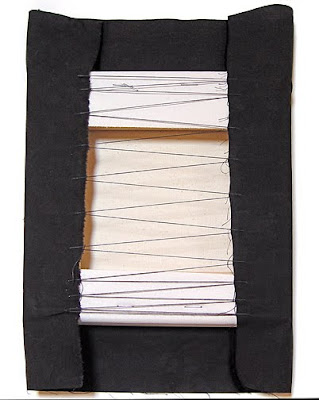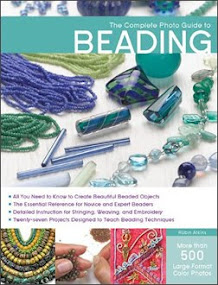
This post is inspired by the quilt by Myrna Giesbrecht pictured above which I saw at an exhibition last November (more about it here). It was set apart from all the other quilts in the show by virtue of the way it was displayed, not hanging soft against the wall, but mounted on a stretched and painted canvas. The artist had painted a stretched canvas black and then sewn the quilt to it, which made the quilt look like a fine art painting. Wow!
Even though it may not be fair to the quality, originality and beauty of the other quilts in the show, I believe Myrna could have sold her quilt for two or three times the amount any of the others could have gotten... because traditionally fine art commands higher monetary value than craft, stitchery, quilts, etc.
Light bulb! I tucked that sweet idea for display of fiber arts/beadwork in the back of my mind for future reference and recently resurrected it because I wanted to enter some of my Bead Journal pieces for this year in our County Fair, and I wanted them in the Fine Arts division! I hoped that mounting them in this way would give them a fine art look. Here's how my three pieces turned out. (All pictures in this post are click-to-enlarge.)

All three (l to r: Release, Believe, Forgive) won blue ribbons, two of them also won "best of class" and one won a "special award gift certificate for art supplies." How's that for an idea that works? And why not share the finishing technique with my blogging friends? OK! Here you go...
How to Mount Beadwork on Canvas Stretcher Frames
Buy a pre-made, canvas-covered stretcher-frame from your local art supplies shop or on-line. No need to get one that is primed as you're going to cover it with fabric. It should be larger than your piece, but not so much larger that your piece is lost in the center of it.

Select a fabric that enhances (but does not in any way detract) from your piece. For the three pieces shown above, I used a black batik. It's a tightly woven, durable fabric with no sheen to it. On close inspection it includes dark red, dark green and dark black in addition to deeply saturated black. I like the way the very subtle colors relate with the colors in my pieces. Cut the fabric about 3 inches larger than the stretcher on each side.
Center your beadwork on the fabric and determine how best to stitch your beading to the fabric. My choice was to whip-stitch over the couching stitches that hold the twisted cording around the perimeter of my piece, using the same holes and matching thread colors. See right and wrong side below.


The next step is to lace the fabric to the frame. I use acid-free photo-mount stickers in the corners of my beadwork to hold it centered on the canvas while I lace it onto the frame.

I use buttonhole thread (but any synthetic beading thread will work as well) and lace side to side first. I make my lacing stitches about a half inch apart at the ends and about an inch apart in the center. At first I simply lace without concern for tension. After the lacing is complete, I work from the starting point to the end, snugging each section of lacing thread as I go. Try to achieve an even tension across the width of the frame, but not so taught that it pulls your beadwork out of shape. Knot off the thread.

Then on the back side, carefully mitre the corners at the top and bottom, folding the fabric inward and pinning it at the corners. Mark the approximate location of the hanging eye-screws. They should be about a third of the way down from the top and about a half inch in from the edge. The reason is that you don't want to cut your vertical lacing threads when you drill the holes for the eye-screws! Record the measurement on scrap paper. The corners should now look like this...

Lace the top to the bottom in the same way as the side lacing. Be careful not to place lacing over or near the marked spots. Snug the tension in the lacing and knot off the thread.

Use a piece of black or kraft paper, acid-free if possible, to cover the lacing. Cut it about one-quarter inch smaller all around than the canvas. I write the title of the piece and the date along the bottom edge of the backing paper and sign it before attaching it. Using double-sided tape or PVA glue all around the edge of the paper, center it over the back of the frame and drop it in place.

Remember the recorded measurement of your drilling spots? Use it to correctly locate the spots and mark them on the backing paper. Use a small hand drill and an appropriately sized bit to drill holes for the eye-screws.

Insert eye-screws. Measure a piece of picture wire 6 inches longer than the distance between the two eye-screws. Insert wire into one of the screws and twist the end around the wire to secure. Do the same on the other side, adjusting the tension so the wire is pretty much straight across. Add felt bumpers to the bottom corners. The completed back side looks like this.

Note: You might ask, why not staple the fabric to the frame, like the canvas? In my opinion, with the beadwork already sewn to the fabric, you need a more forgiving method. You need to be able to delicately adjust both the tension and the positioning of the beadwork relative to the frame. To do that with staples would be tricky at best.
I am so pleased with how professional my pieces look mounted/framed in this way! Originally, I had planned to bind them into a hand-made book. Because everything is stitched rather than glued, I can easily disassemble these pieces and re-mount them in my book. But after seeing how they look like this, I'm tempted to change my mind and display all twelve pieces this way..

















That is so clever and certainly worth trying.. Gerry K.
ReplyDeleteWow -- talk about useful! I have been looking for a better way to display my pieces, which are just in a drawer right now, unmounted and with the fabric's unfinished edges all around. I don't know if all of them will ultimately get this treatment, but several of them will really work well like this. Thank you!!!
ReplyDeleteWhat a wonderful idea!!!! I love how your gorgeous embroidery looks framed like this! Thank you so much for sharing your lovely idea!! I am very inspired now...
ReplyDeleteThank you very much for showing us this clever way of mounting a bead embroidery. Quite honestly, I don't believe that I would ever have thought of this possibility myself. Think I will have a go at it soon, as I have several pieces ready for finishing off.
ReplyDeleteSabine
Congratulations on the ribbons. Mounting them does make them more customer appealing.
ReplyDeleteThat's fab! I did a simpler version of that to mount my first year of BJP pieces. I painted the canvases and stitched the pieces directly to them. I was worried that a fabric covering would sag, because most of my pieces were really heavy. I'm sure that could be solved by taking a few stitches through all layers before doing the lacing though. Thanks for the additional ideas!
ReplyDeleteFabulous idea, and WAY cheaper than paying for professional framing and matting. THIS I can do myself! Thanks for the lesson.
ReplyDeleteCongrats on the ribbons as well!
Carol S.
Thank you Robin. What a great idea! Your squares look wonderful.
ReplyDeleteTimely post for me, Robin! I was just about to start stapling fabric to a canvas frame, but your way should give me a smoother surface, as I can even the fabric out as I stitch. Thanks!
ReplyDeleteAnd I appreciate your comment on my blog - I've made a new post about my process that I'd love to hear your thoughts on - http://bit.ly/9FpboU
Great idea - and thank you so much for sharing all the steps and details. I know this took a lot of time and effort - what a gift to all of us.
ReplyDeleteGreat idea. I use to do this with my cross stitch (OMG how many years ago did I do THAT!?). I've been toying with doing some flat work lately & you just gave me the push to try this. OH AND CONGRATS! on the Fair!!!!
ReplyDeletedot
Oooo... great way to showcase your art, Robin... I think I'll use this technique on quite a few projects I have laying around!!
ReplyDeleteThanks!
Thank you for sharing this technique. I have quite a few projects that I think would lend themselves well to this.
ReplyDeleteCongrats on your ribbons!
Bravo Robin!
ReplyDeleteCongratulations for the ribbons and thank you for taking the time to write detailed instructions. I did something similar with a quilting project that imitates the stained glass technique and it looks great. I will surely try your suggestion with some beading projects.
Bravo Robin!
ReplyDeleteCongratulations for the ribbons and thank you for taking the time to write detailed instructions. I did something similar with a quilting project that imitates the stained glass technique and it looks great. I will surely try your suggestion with some beading projects.
Interesting finishing techniques. I usually just stich beadwork directly to the canvas! ;) :D
ReplyDeleteWhat a great idea! Thank you for sharing. Well worth trying and will show my daughter as she loves quilting. I will defently give it a go sometime but not at the present as last night I broke my wrist so will be out of action for 2 months.
ReplyDeleteThe beadwork looks very elegant mounted like this. I really does add an extra sense of professionalism and enhance the embroideries as works of art.
ReplyDeleteAnd thanks for sharing the technique -- I must try it some time!
Wonderful idea! Congratulations on your wins, too!
ReplyDeleteI'm going to share this link on Twitter.
Ever better!
ReplyDeleteThanks door sharing this technique!
M
Thanks for the tut, Robin! I've used a variation of this technique, but I do like your use of the photo stickers to keep everything in place. I hadn't thought of that. Also, I've done the lacing before, but not on a canvas. It's a great tip!
ReplyDeleteI forgot to say congrats on your wins! Well deserved, as usual! Also, did you know that Myrna Giesbrecht is another Canadian. I believe she even lives in B.C
ReplyDeleteWhat a great idea, Robin. I think this may be the way I put all my BJP pieces together and display. Thanks for the step by step instructions.
ReplyDeleteI LOVE this idea. And a big "Woooohooooo" on the blue ribbons...You rock!!
ReplyDeleteI came across this posting while looking for something else. I'm glad you enjoyed my piece. It's not stitched to the canvas. It's glued. I spent a lot of time experimenting with how to get that to work. I know I talk about it on my blog sometime but can't tell you the link off hand right now. Enjoy mounting your pieces. I think it makes a tremendous difference in how they are viewed.
ReplyDelete- Myrna Giesbrecht
I loved that Quilt! Thank you very much for the mounting tutorial it was very imformative I will use that with my project I am finishing up.
ReplyDeleteAnalisa
I am trying to get caught up with everything lately. Being a caregiver takes time! I especially like the idea of your "6 words." I am sure that whatever those words might be that they would be a way to seek greater insight and spirituality in life. We are often in such a hurry that we gloss over our feelings and events without fully experiencing them. Result? It could mean that our body/mind holds it simmering until it can no longer be ignored, whether through an emotional release or physical symptoms. You are such a wise lady!
ReplyDeleteHi Robin!
ReplyDeleteGreat insight (as always!!).
You've pushed me in a different direction to experiment with a large piece that I need to finish.
One question though --- where did you find your hand drill?
I would like to find one that size and have been looking since you posted this, but can't locate one!
TIA !
Katie